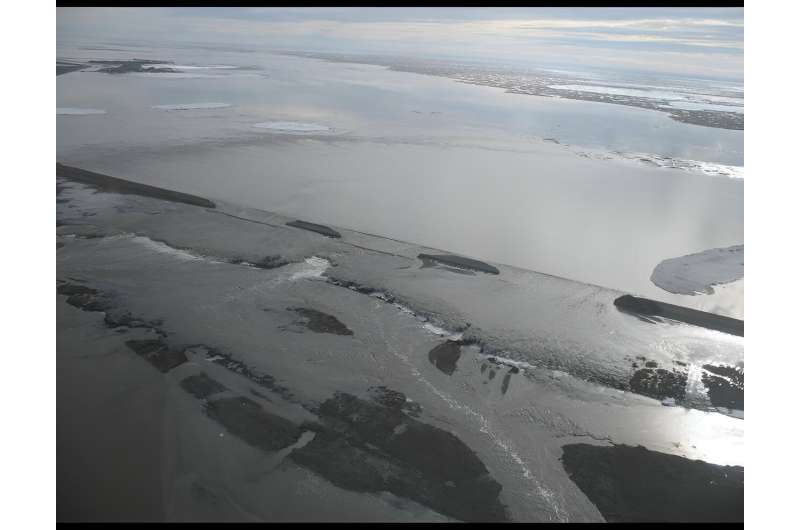This article has been reviewed according to Science X's editorial process and policies. Editors have highlighted the following attributes while ensuring the content's credibility:
fact-checked
peer-reviewed publication
trusted source
proofread
Flooding that closed Alaska's Dalton Highway also caused widespread ground sinking

The massive 2015 flooding of the Sagavanirktok River in northern Alaska had immediate impacts, including closure of the Dalton Highway for several days, but it also contributed to longer-term ground subsidence in the permafrost-rich region.
That's the finding by assistant professor Simon Zwieback at the University of Alaska Fairbanks Geophysical Institute in a study published Sept. 27 by the journal Permafrost and Periglacial Processes.
Zwieback is the paper's lead author. UAF scientists Mikhail Kanevskiy, Donald Walker, Vladimir Romanovsky and Franz Meyer are among the nine co-authors.
Zwieback, who also teaches at the UAF College of Natural Science and Mathematics, specializes in using space-borne remote sensing to study the Arctic.
"What previously hadn't been known is that subsequent to the flood there were diffuse and variable changes to tundra and to this permafrost landscape," Zwieback said. "In particular, we observed that in areas that were flooded, there were several hotspots of subsidence with subsidence exceeding three inches over a few years. And we also observed many more areas with less pronounced but still measurable sub-segments.
"We also observed a green-up and a wettening of the landscape, which was also quite variable," he said. "All of this is important for understanding how these landscapes react to floods."
Floodwaters began spilling onto the Dalton Highway, Alaska's road to the North Slope, in mid-May 2015 and also reached Deadhorse airport. A pre-flood buildup of aufeis, layered ice that formed from the freezing of river water, is seen as the leading cause of the chaotic flooding. Aufeis diverted the thawing river's water away from natural channels.
The river's massive floodwaters exacerbated what the authors describe as a "complicated relationship" between rivers and their floodplains in regions of continuous permafrost. Human activity in the area, driven by continued expansion of the Prudhoe Bay oilfield and the presence of the Dalton Highway, has also interfered with natural drainage.
The flood may have stimulated subsidence by warming the ground, causing ground ice to melt, the authors state. Warming can be due to increased wetness, disturbance to the protective layer of organic matter or sediment deposition, allowing more heat to penetrate.
Zwieback analyzed satellite data from 2015 through 2019 to estimate ground deformation over the post-flood years.
"What we did observe from space was widespread but also quite variable subsidence," Zwieback said.
Subsidence was most pronounced in flooded locations and was most active in the two years after the flood.
"We interpret the subsidence that we observed with remote sensing to be largely due to melting of ground ice," Zwieback said. "Soils in the area contain substantial quantities of ice in the form of ice wedges and segregated ice, small lenses of ice as opposed to big chunks."
Ice wedges are generally anywhere from about three to 10 feet across and about six to 10 feet deep at their narrow bottom. They form regular networks and in the study area are typically found about 30 feet apart.
"One of the main complicating factors here is that initial subsidence can trigger changes at the surface, such as ponding of water," Zwieback said. "The surface becomes darker and warmer. And that means more thawing underneath, because you have changed the surface conditions."
Subsidence occurred in some areas with high ice content but not in others, indicating multiple factors driving deformation. These can include organic layer disturbance and sediment deposition, which settles into the soil and drives out its insulating air pockets and allows more heat to penetrate. Researchers found fine grain sediment in the top two inches of soil plugs taken at two locations but could not conclusively state the sediment derived from the flood, despite the sample site being nearly 1,000 feet from the highway.
Researchers also found that, on average, subsiding ice-rich locations showed increases in greenness and wetness. Conversely, many ice-poor floodplains greened without deforming.
Nevertheless, the paper notes that flooding can be beneficial in the long term. It deposits sediment, which in turn allows for an increase in insulating vegetation cover and other organic matter. Over time, the active layer—a layer of soil that freezes in winter and thaws in the summer—thins. That thinning in turn allows growth of ice wedges and segregated ice. All of this increases elevation and reduces flood frequency, the authors write.
The new research is important as the Arctic comes under increasing climate stresses.
"With the Arctic becoming wetter and the flood regime changing, we need to understand how riverine landscapes respond to these changes in the rivers and the floods associated with those rivers," Zwieback said.
More information: Simon Zwieback et al, Disparate permafrost terrain changes after a large flood observed from space, Permafrost and Periglacial Processes (2023). DOI: 10.1002/ppp.2208
Journal information: Permafrost and Periglacial Processes
Provided by University of Alaska Fairbanks




















